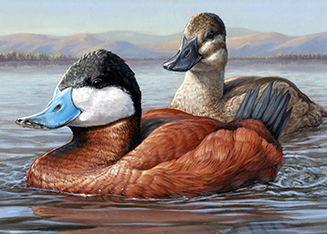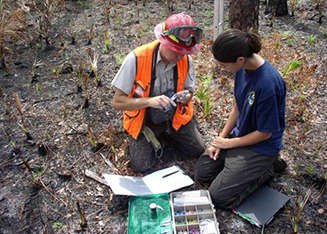Parts Collection Surveys
Wing Surveys or "Wingbees"
Each year the U.S. Fish & Wildlife Service conducts the Migratory Bird Parts Collection Survey, often referred to as the Wing Survey. This survey is used to obtain detailed information about the harvest of migratory game birds and includes parts surveys for waterfowl, dove and woodcock. The Service asks a sample of hunters from across the U.S. to send in one wing from each duck, dove and woodcock that they shoot, and the wing tips and tail feathers from each goose. Before the start of every hunting season, the Service provides each survey participant with postage-paid wing envelopes for them to send in their parts. These wing envelopes are addressed to one of the four collection points throughout the U.S., one in each flyway.
Nationwide, the Service receives about 90,000 duck wings, 20,000 goose tails and wing tips, 10,000 dove wings, and 8,000 woodcock wings annually. Envelopes begin arriving at the collection sites in each flyway in September, soon after the hunting season starts in Alaska and the early Canada Goose season starts in the lower 48 states. When the parts arrive, they are sorted by species and stored in a freezer until late February. Within each flyway, state and federal biologists examine these parts in greater detail at events called wingbees. Data from wingbees provide estimates of the species, sex, and age composition of the harvest, in addition to supplying information on how harvest changes over space and time. These data from the Wing Surveys are important pieces of information used in waterfowl population models and help waterfowl managers set and evaluate hunting seasons.
If you are a participant in the Wing Survey and need additional wing envelopes, please visit HIPWeb.
How It Works
Identification
Different species of ducks often have distinct color patterns on their wing feathers that biologists can use to identify the species of each wing. For example, Mallards have an easily recognizable iridescent purple speculum bordered by two white bars. In contrast, male Northern Pintails have a partly iridescent green speculum and females have a dull bronze speculum. Most wings can easily be identified to species by learning wing feather coloration. Similarly, the species of a goose can be determined from the size and the color of its tail feathers.
Analysis
Identifying the species of the parts allows the Service to determine the species composition of the sample. That information combined with the estimates of total harvest from the Waterfowl Hunter Survey allows a calculation of species-specific harvest estimates. For example, if the estimated duck harvest for the Pacific Flyway was 2 million and 10% of the wing sample was Pintails, then the Pacific Flyway's estimated Pintail harvest would be 200,000 (10% of the total duck harvest). After the species is determined, biologists examine the parts in greater detail to determine the sex and age (adult or young-of-the year).
Sex and Age Determination
Sometimes there are obvious differences between sexes or ages. For example, Pintail males and females have different color speculums making sex determination very apparent. On other species, the differences are more subtle, and biologist must look for differences in coloration on one or two feathers. Similarly, age determination of each wing or goose tail is done by looking for slight differences in feather shape, color, pattern, wear, or replacement. Aging each part allows the Service to calculate an age ratio (the number of young-of-the-year birds harvested per adult) for each species.
Measuring Production
Age ratios in the harvested sample are very important because they provide a way to estimate species productivity during the previous breeding season. For example, when waterfowl production is high, hunters tend to shoot more young birds than adults. Conversely, when production is low, age ratios in the harvest also tend to be lower. Age ratios from the wingbees have been used to measure continental waterfowl production for over 40 years. However in recent years, age ratios have taken on a new importance because they are used in conjunction with other data as critical inputs to Adaptive Harvest Management models which are used to set and evaluate hunting seasons.
Data generated from the annual Wing Survey are very important for managing our waterfowl resource and helping to secure the future of waterfowl and waterfowl hunting for generations to come.


